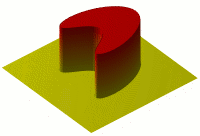Partial differential equation facts for kids
Partial differential equations (often called PDEs) are special kinds of math problems. They help us understand how things change in the world around us. Imagine you want to know how heat spreads through a metal bar, or how waves move in the ocean. PDEs are the tools mathematicians and scientists use to describe these changes.
Unlike simpler equations that deal with just one variable, PDEs deal with several variables at once. For example, the temperature of something might depend on where you are (like the x, y, and z coordinates) and also on time. PDEs help us connect all these changes together.
Contents
What are Partial Differential Equations?
Partial differential equations are mathematical equations that include partial derivatives. A partial derivative tells us how a function changes when only one of its variables changes, while the others stay the same. Think of it like this: if you're walking on a hill, a partial derivative could tell you how steep the hill is if you only walk north, ignoring how it changes if you walk east or west.
PDEs are used to describe many things in nature and science. They are super important in fields like physics, engineering, and even finance.
Why are PDEs important?
PDEs are important because they help us model and predict how complex systems behave. Here are some examples:
- Weather forecasting: Scientists use PDEs to predict how air pressure, temperature, and wind change, which helps them forecast the weather.
- Designing airplanes: Engineers use PDEs to understand how air flows around an airplane wing, making planes safer and more efficient.
- Medical imaging: PDEs are used in technologies like MRI scans to create detailed pictures of the inside of the human body.
- Understanding waves: Whether it's sound waves, light waves, or ocean waves, PDEs help us describe how they move and interact.
How do PDEs work?
Imagine you have a function that describes something, like the temperature of a room. This temperature might change depending on where you are in the room (your position) and also on time. A PDE would link how the temperature changes with position to how it changes with time.
For example, the heat equation is a famous PDE. It describes how heat spreads out over time. If you put a hot object in a cold room, the heat equation can tell you how the temperature will change in different parts of the room as time passes.
Solving PDEs can be quite complex. Often, mathematicians and computer scientists use powerful computers to find solutions, especially for real-world problems.
Common types of PDEs
There are many different types of partial differential equations, each used for specific situations. Some of the most well-known include:
- The Heat Equation: Describes how heat or diffusion spreads through a material.
- The Wave Equation: Describes how waves (like sound waves, light waves, or water waves) travel through space and time.
- Laplace's Equation: Used in fields like electromagnetism and fluid dynamics to describe steady states, where things are not changing over time.
These equations help scientists and engineers understand and control many natural phenomena and technological systems.
Related pages
Images for kids
See also
 In Spanish: Ecuación en derivadas parciales para niños
In Spanish: Ecuación en derivadas parciales para niños



